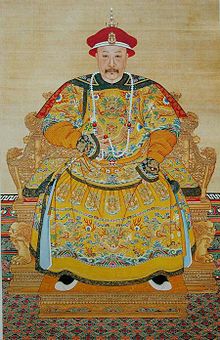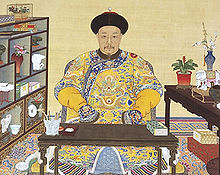- Jiaqing Emperor
-
Jiaqing Emperor  7th Qing Emperor of China
7th Qing Emperor of ChinaReign 9 February 1796 – 2 September 1820
(24 years, 206 days)Predecessor Qianlong Emperor Successor Daoguang Emperor Regent Qianlong Emperor (1796-1799) Spouse Empress Xiaoshurui
Empress XiaoheruiIssue Mianmu, Prince Mu
Princess Zhuangjing
Mianning, Daoguang Emperor
Princess Zhuangjing
Princess Huian
Miankai, Prince Dun
Mianxin, Prince Rui
Mianyu, Prince HuiFull name Chinese: Aixin-Jueluo Yǒngyǎn 愛新覺羅永琰, later Yóngyǎn 顒琰
Manchu: Aisin-Gioro Yong YanPosthumous name Emperor Shòutiān Xìngyùn Fūhuà Suīyóu Chóngwén Jīngwǔ Guāngyù Xiàogōng Qínjiǎn Duānmǐn Yīngzhé Ruì
受天興運敷化綏猷崇文經武光裕孝恭勤儉端敏英哲睿皇帝Temple name Qing Rénzōng
清仁宗Father Qianlong Emperor Mother Empress Xiaoyichun Born 13 November 1760
Old Summer Palace, BeijingDied 2 September 1820 (aged 59)
Chengde summer palace, modern HebeiBurial Western Qing Tombs The Jiaqing Emperor (Chinese: 嘉慶帝; pinyin: Jiāqìngdì; Mongolian: Sayishiyaltu Yirugertu Khaan, 13 November 1760 – 2 September 1820) was the seventh emperor of the Manchu-led Qing dynasty, and the fifth Qing emperor to rule over China, from 1796 to 1820.
He was the son of the Qianlong Emperor. During his reign, he prosecuted Heshen (和珅) (the corrupt favourite of Qianlong) and attempted to restore the state and curb the smuggling of opium inside China.
Contents
Early years
He was born at the Old Summer Palace (圆明园/圓明園), 8 km (5 mi) northwest of the walls of Beijing, and was given the name Yongyan (永琰), changed into Yongyan (顒琰) when he became emperor: the first character of his private name was changed from 永 to 顒, both pronounced Yong, as the former is used commonly. This novelty was introduced by his father the Qianlong Emperor who thought it not proper to use a common character in the emperor's private name due to the long-standing practice of naming taboo.
He was the fifteenth son of the Qianlong Emperor. His mother was a Han Chinese concubine of the second rank Ling (令贵妃/令貴妃), who became a favorite of Qianlong. She was posthumously made Empress Xiaoyichun (孝仪纯皇后/孝儀純皇后) when her son became emperor. She was the daughter of Wei Qingtai (魏清泰), an official in the Qing administration whose Han Chinese family had long been integrated in the Manchu elites. In 1818 Emperor Jiaqing made his mother's family officially Manchu, and changed their Chinese family name Wei into the Manchu clan name Weigiya.
After the first two original choices for heir to the throne succumbed early to disease, in December 1773 Yongyan was secretly chosen by Qianlong to be the next emperor. In 1789 he was made Prince of the 1st rank Jia (嘉亲王/嘉親王).
At the end of his reign, Qianlong worked closely with a Manchu government minister called Heshen. Prince Jia hated the notoriously corrupt Heshen for his abuse of power, and vowed to punish the minister once he became emperor.
Accession to the throne
In October 1795, in the 60th year of his reign, Emperor Qianlong announced his intention to abdicate in favor of Prince Jia: he did not think it proper to rule longer than his grandfather, the late Kangxi Emperor. Prince Jia acceded to the throne and proclaimed the era name of Jiaqing in February 1796. For the next three years however, Jiaqing ruled as Emperor in name only. Decisions were made by his father, the Retired Emperor Qianlong.
With the death of Qianlong at the beginning of February 1799, Jiaqing took control of the government and prosecuted Heshen. Heshen was charged with corruption and abuse of power. He was stripped of his titles and properties, and ordered to commit suicide. Heshen's daughter-in-law, Princess He Xiao, a sister of the new emperor, was spared from punishment and given a few properties from Heshen's estates.
At the time the empire faced internal disorder, most importantly the large-scale White Lotus (1796–1804) and Miao Rebellions (1795–1806), as well as an empty treasury. Emperor Jiaqing engaged in the pacification of the empire and the quelling of rebellions. He endeavored to bring China back to its 18th-century prosperity and power. However, due in part to large outflows of silver from the country as payment for the opium smuggled into China from British India, the economy declined.
Court intrigues and incidents
Members of the Qing royal family (relatives of Jiaqing) tried to assassinate him twice - in 1803 and in 1813. The princes involved in the attempts on his life were executed. Other members of the imperial family, numbering in the hundreds, were exiled.[1][2][3]
Opposition to Christianity
The Great Qing Code includes one statute titled "Prohibitions Concerning Sorcerers and Sorceresses" (禁止師巫邪術). In 1811 a clause was added to it with reference to Christianity. It was modified in 1815 and 1817, settled in its final form in 1839 under the Daoguang Emperor, and abrogated in 1870 under the Tongzhi Emperor. It sentenced Europeans to death for spreading Catholicism among Chinese and Manchus. Christians who would not repent their conversion were sent to Muslim cities in Xinjiang, to be given as slaves to Muslim leaders and beys.[4]
Family
Consorts
Empresses
Per Imperial Regulations, there was only one Empress at any given time. However, that did not prevent others from being elevated to that position after the death of an existing Empress. During Jiaqing's reign, there were two Empresses, each serving in different periods of time:
- Lady Hitara of the Hitara (Manchu) clan, who became Empress when Emperor Jiaqing ascended the throne in 1796. She was the mother of Emperor Daoguang (2nd son of Emperor Jiaqing) She is known posthumously as Empress Xiaoshurui (孝淑睿皇后).
- Empress Xiaoherui, of the Niohuru clan (孝和睿皇后) (1776–1849), elevated after the existing Empress died in 1798.
Imperial Noble Consorts
Per Imperial Regulations, only two Imperial Noble Consorts are allowed at any given time.
- The Imperial Noble Consort Gong Shun, of the Niohuru clan (恭順皇貴妃) (1787–1860).
- The Imperial Noble Consort He Yu (? - 1833) of the Lugiya clan.
Consorts
Per Imperial Regulations, only four Consorts are allowed at any given time. Not counting those who were later elevated to higher titles and those who were elevated posthumously, there was effectively only two consorts during Jiaqing's reign.
- The Consort Hua (? - 1808) of the Hougiya clan.
- The Consort Zhuang (? - 1811) of the Wang clan.
- The Consort Shu of the Wanyan clan (Posthumously elevated. Never served as Consort in life)
Imperial Concubines
Per Imperial Regulations, only six Imperial Concubines are allowed at any given time.
- The Imperial Concubine En (?-1846) of the Wuya clan
- The Imperial Concubine Xuan of the Chengiya clan
- The Imperial Concubine Jian (? - 1780) of the Guangiya clan
- The Imperial Concubine Rong (? - 1826) of the Liang clan
- The Imperial Concubine Chun (? - 1819) of the Dongiya clan
- The Imperial Concubine An (? - 1837) of the Guargiya clan
Children
Sons
- First son: Mianmu, son of Imperial Noble Consort He Yu.
- Second son: Prince Mianning (綿寧) ( 16 September 1782 – 25 February 1850), son of Empress Xiaoshurui (Lady Hitara), succeeded his father as the Daoguang Emperor in 1820
- Third son: Prince Miankai (绵恺), son of Empress Xiaoherui, of the Niohuru clan
- Fourth son: Prince Mianxin (绵忻), son of Empress Xiaoherui, of the Niohuru clan
- Fifth son: Prince Mianyu (绵愉) (1814–1865). Son of Gongshun Huang Kuai Fei, of the Niohuru clan
Daughters
- First daughter (1780–1783) her mother was Imperial Concubine Xuan.
- Second daughter(1780–1783) her mother was Empress Xiaoshurui.
- Princess Zhuangjing [庄敬和硕公主] (1781–1811) daughter of He Yu Huang Kuai Fei.
- State Princess Zhuangjing [庄静固伦公主] (1784–1811) daughter of Empress Xiaoshurui.
- Princess Hui-An (1786–1795).
- Sixth daughter (1789–1790) daughter of Hua Fei.
- Seventh daughter (1793–1795) daughter of Empress Xiaoherui.
- Eight daughter (1805) daughter of Gongsun Huang Kuai Fei.
- Ninth and final daughter (1811–1815) State Princess Huimin (慧悯固伦公主) post-humously in 1820, daughter of Gongsun Huang Kuai Fei.
Death and burial
On 2 September 1820, the Jiaqing Emperor died at the Rehe (Jehol) Traveling Palace (熱河行宫), 230 km (140 mi) northeast of Beijing, where the imperial court was in summer quarters. The Draft History of Qing did not record a cause of death. Some have alleged that he died after being struck by lightning, but others prefer the theory that he died of a stroke as the emperor was quite obese. He was succeeded by his second son, the Daoguang Emperor.
Renzong was interred amidst the Western Qing Tombs, 120 km (75 mi) southwest of Beijing, in the Changling (昌陵 - meaning "Splendid tomb") mausoleum complex.
Ancestry
Ancestors of the Jiaqing Emperor Shunzhi Emperor Kangxi Emperor Empress Xiaokangzhang Yongzheng Emperor Uya Weiwu Empress Xiaogongren Qianlong Emperor Niuhuru Eidu Niuhuru Lingzhu Empress Xiaoshengxian Yongyan, Jiaqing Emperor Wei Qingtai Weigiya, Empress Yi Chun References
 This article incorporates text from China in the light of history, by Ernst Faber, a publication from 1897 now in the public domain in the United States.
This article incorporates text from China in the light of history, by Ernst Faber, a publication from 1897 now in the public domain in the United States. This article incorporates text from China in the light of history, by Ernst Faber, a publication from 1897 now in the public domain in the United States.
This article incorporates text from China in the light of history, by Ernst Faber, a publication from 1897 now in the public domain in the United States. This article incorporates text from The Chinese recorder, Volume 27, a publication from 1896 now in the public domain in the United States.
This article incorporates text from The Chinese recorder, Volume 27, a publication from 1896 now in the public domain in the United States. This article incorporates text from Life among the Chinese: with characteristic sketches and incidents of missionary operations and prospects in China, by Robert Samuel Maclay, a publication from 1861 now in the public domain in the United States.
This article incorporates text from Life among the Chinese: with characteristic sketches and incidents of missionary operations and prospects in China, by Robert Samuel Maclay, a publication from 1861 now in the public domain in the United States.
- ^ Ernst Faber (1897). China in the light of history. American Presbyterian mission press. p. 17. http://books.google.com/books?id=WvpWAAAAMAAJ&q=the+emperor+tao+kwang%27s+son+died+in+1831+at+the+age+of+twenty+from+a+blow+inflicted+by+his+father#v=snippet&q=attempt%20kia%20hing&f=false. Retrieved 2011-06-6.
- ^ The Chinese recorder, Volume 27. American Presbyterian Mission Press. 1896. p. 242. http://books.google.com/books?id=lNAWAQAAIAAJ&pg=PA242&dq=the+emperor+tao+kwang's+son+died+in+1831+at+the+age+of+twenty+from+a+blow+inflicted+by+his+father&hl=en&ei=KVPtTYzUAej30gH0-aybAQ&sa=X&oi=book_result&ct=result&resnum=2&ved=0CDMQ6AEwAQ#v=onepage&q=the%20emperor%20tao%20kwang's%20son%20died%20in%201831%20at%20the%20age%20of%20twenty%20from%20a%20blow%20inflicted%20by%20his%20father&f=false. Retrieved 2011-06-6.
- ^ Ernst Faber (1897). China in the light of history. American Presbyterian mission press. p. 17. http://books.google.com/books?id=S2hCAAAAIAAJ&pg=PA18&dq=the+emperor+tao+kwang's+son+died+in+1831+at+the+age+of+twenty+from+a+blow+inflicted+by+his+father&hl=en&ei=KVPtTYzUAej30gH0-aybAQ&sa=X&oi=book_result&ct=result&resnum=1&ved=0CC4Q6AEwAA#v=onepage&q=life%20attempt%20kia-hing&f=false. Retrieved 2011-06-6.
- ^ Robert Samuel Maclay (1861). Life among the Chinese: with characteristic sketches and incidents of missionary operations and prospects in China. Carlton & Porter. p. 336. http://books.google.com/books?id=BZAPAAAAIAAJ&q=mohammedan#v=onepage&q=mohammedan%20slaves%20to%20beys&f=false. Retrieved 2011-7-06.
Jiaqing EmperorHouse of Aisin-GioroBorn: 13 November 1760 Died: 2 September 1820Regnal titles Preceded by
The Qianlong EmperorEmperor of China
1796-1820Succeeded by
The Daoguang EmperorCategories:- 1760 births
- 1820 deaths
- Qing Dynasty emperors
- 18th-century Chinese monarchs
- 19th-century Chinese monarchs
Wikimedia Foundation. 2010.


